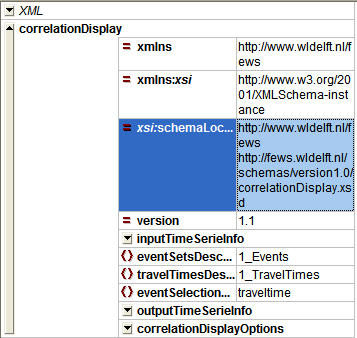Summary
This howto describes how to configure a preferred equation for a correlation plot (using the correlationdisplay). It describes how to adjust the CorrelationDisplay config file and/or the traveltimes file to select a default for a specific correlation.
Description
The files defining what is shown in the correlation display are stored in the DisplayConfigFiles directory. For each correlation a number of elements must be configured:
- inputTimeSerieInfo: Historic time series sets information.
Parameter id is required for calculating correlation. The other variables are required for running the forecast hydrograph. - eventSetsDescriptorId: Correlation event sets descriptor ID
- travelTimesDescriptorId: Travel times descriptor ID
- eventSelectionType: Selection type: event id selection or travel time selection.
A (new) optional element has been added which allows to set a preferred equation-type for the selected correlation: defaultEquation. This elements has to attributes: equationType (required) and polynomialOrder (optional). This element should be the last element of a CorrelationDisplay config file.
The following options are available for the equationType attribute:
- polynomial
- simple_linear
- multiple_linear
- exponential_divide
- exponential_multiply
- power
- logarithmic
- hyperbolic
This setting can be used to change the default for an entire group. To set the default for a single upstream/downstream combination the same element can also be set in the traveltimes file.
Configuration Steps for the CorrelationDisplay config file
- Open an existing configuration file. In xmlspy grid view it may look like this:
In XML it will look like this:
| Code Block | ||||
|---|---|---|---|---|
| ||||
| Wiki Markup | ||||
h1. Summary This howto describes how to configure a preferred equation for a correlation plot (using the correlationdisplay). It describes how to adjust the CorrelationDisplay config file and/or the traveltimes file to select a default for a specific correlation. h1. Description The files defining what is shown in the correlation display are stored in the DisplayConfigFiles directory. For each correlation a number of elements _must_ be configured: - _inputTimeSerieInfo:_ Historic time series sets information. Parameter id is required for calculating correlation. The other variables are required for running the forecast hydrograph. - _eventSetsDescriptorId:_ Correlation event sets descriptor ID - _travelTimesDescriptorId:_ Travel times descriptor ID - _eventSelectionType:_ Selection type: event id selection or travel time selection. A (new) optional element has been added which allows to set a preferred equation-type for the selected correlation: defaultEquation. This elements has to attributes: equationType (required) and polynomialOrder (optional). This element should be the last element of a CorrelationDisplay config file. The following options are available for the equationType attribute: - polynomial - simple_linear - multiple_linear - exponential_divide - exponential_multiply - power - logarithmic - hyperbolic This setting can be used to change the default for an entire group. To set the default for a single upstream/downstream combination the same element can also be set in the traveltimes file. h2. Configuration Steps for the CorrelationDisplay config file - Open an existing configuration file. In xmlspy grid view it may look like this: !corr1.png! In XML it will look like this: {code:xml} <?xml version="1.0" encoding="UTF-8"?> <correlationDisplay xmlns="http://www.wldelft.nl/fews" xmlns:xsi="http://www.w3.org/2001/XMLSchema-instance" xsi:schemaLocation="http://www.wldelft.nl/fews http://fews.wldelft.nl/schemas/version1.0/correlationDisplay.xsd" version="1.1"> <inputTimeSerieInfo> <moduleInstanceId>ImportTelemetry</moduleInstanceId> <parameterId>H.obs</parameterId> <timeSeriesType>external historical</timeSeriesType> <timeStep unit="minute" multiplier="15" divider="1"/> <relativeViewPeriod unit="day" end="2" start="-4"/> <readWriteMode>add originals</readWriteMode> </inputTimeSerieInfo> <eventSetsDescriptorId>1_Events</eventSetsDescriptorId> <travelTimesDescriptorId>1_TravelTimes</travelTimesDescriptorId> <eventSelectionType>traveltime</eventSelectionType> <outputTimeSerieInfo> <moduleInstanceId>ImportTelemetry</moduleInstanceId> <parameterId>H.simulated</parameterId> <timeSeriesType>simulated forecasting</timeSeriesType> <timeStep unit="minute" multiplier="15" divider="1"/> <relativeViewPeriod unit="day" start="-4" end="2"/> <readWriteMode>add originals</readWriteMode> </outputTimeSerieInfo> <correlationDisplayOptions> <scatterplotOptions> <preferredColor>red</preferredColor> <markerStyle>circle</markerStyle> <markerSize>8</markerSize> </scatterplotOptions> <equationOptions> <lineStyle>solid</lineStyle> <markerStyle>none</markerStyle> </equationOptions> </correlationDisplayOptions> </correlationDisplay> {code} - Now add the following to the end of the file (_before_ the final </correlationDisplay> element): <defaultEquation |
- Now add the following to the end of the file (before the final </correlationDisplay> element): <defaultEquation equationType="simple_linear"/>.
...
- In
...
- xmlspy
...
- grid
...
- view
...
- it
...
- will
...
- now
...
- look
...
- like
...
- this:
...
Code Block xml xml <?xml version="1.0" encoding="UTF-8"?> <correlationDisplay xmlns="http://www.wldelft.nl/fews" xmlns:xsi="http://www.w3.org/2001/XMLSchema-instance" xsi:schemaLocation="http://www.wldelft.nl/fews http://fews.wldelft.nl/schemas/version1.0/correlationDisplay.xsd" version="1.1"> <inputTimeSerieInfo> <moduleInstanceId>ImportTelemetry</moduleInstanceId> <parameterId>H.obs</parameterId> <timeSeriesType>external historical</timeSeriesType> <timeStep unit="minute" multiplier="15" divider="1"/> <relativeViewPeriod unit="day" end="2" start="-4"/> <readWriteMode>add originals</readWriteMode> </inputTimeSerieInfo> <eventSetsDescriptorId>1_Events</eventSetsDescriptorId> <travelTimesDescriptorId>1_TravelTimes</travelTimesDescriptorId> <eventSelectionType>traveltime</eventSelectionType> <outputTimeSerieInfo> <moduleInstanceId>ImportTelemetry</moduleInstanceId> <parameterId>H.simulated</parameterId> <timeSeriesType>simulated forecasting</timeSeriesType> <timeStep unit="minute" multiplier="15" divider="1"/> <relativeViewPeriod unit="day" start="-4" end="2"/> <readWriteMode>add originals</readWriteMode> </outputTimeSerieInfo> <correlationDisplayOptions> <scatterplotOptions> <preferredColor>red</preferredColor> <markerStyle>circle</markerStyle> <markerSize>8</markerSize> </scatterplotOptions> <equationOptions> <lineStyle>solid</lineStyle> <markerStyle>none</markerStyle> </equationOptions> </correlationDisplayOptions> <defaultEquation equationType="power"/> </correlationDisplay>
...
- Done:
...
- the
...
- display
...
- will
...
- now
...
- take
...
- this
...
- default
...
- instead
...
- of
...
- the
...
- normal
...
- one.
...
Configuration
...
steps
...
for
...
the
...
traveltimes
...
file
...
- Open
...
- the
...
- he
...
- traveltimes
...
- file
...
- in
...
- which
...
- the
...
- correlation
...
- is
...
- defined
...
- you
...
- want
...
- to
...
- change.
...
- Add
...
- a
...
- defaultEquation
...
- element
...
- to
...
- each
...
- of
...
- the
...
- travelTime
...
- elements
...
- that
...
- you
...
- want
...
- to
...
- changes.
...
- See
...
- the
...
- figure
...
- below
...
- for
...
- an
...
- example.
...


